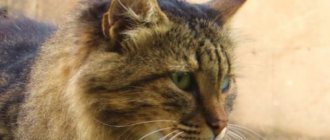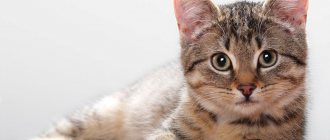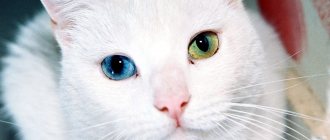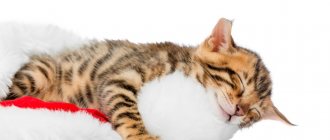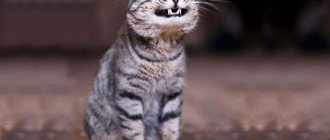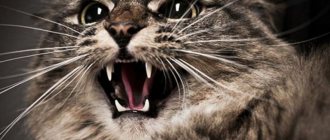A cat’s cough is a natural physiological reaction of the animal’s body to irritation., development of pathology in the respiratory tract. In the process, due to reflexive muscle contraction, accumulations of mucus, pus, blood, as well as foreign bodies are removed.
Usually, the situation when a cat coughs and wheezes at the same time confuses its owner. You need to know how to provide first aid to an animal, and then contact a veterinarian who will solve the problem professionally.
Mechanism of cough development
Usually, the situation when a cat coughs and wheezes at the same time confuses its owner.
A cat’s cough manifests itself specifically:
- the stomach is pulled inward;
- the spine arches in the shape of a question mark;
- the neck is greatly extended;
- the animal's head is pressed to the floor;
- a sharp, loud sound comes out of the open mouth.
The reason for contacting a veterinarian is a periodic or constant cough.
First wince when breathing stops
In the most critical situation, when the cat has stopped breathing, it may be necessary to perform artificial respiration and chest compressions. The process is as follows:
- Lay the cat straight, fix its position so that the neck is in a straight line with the spine;
- The animal's mouth must be closed. If necessary, it must be freed from foreign objects, saliva, mucus;
- Exhale air into the animal’s nose through a cupped palm. The frequency of exhalations depends on the size of the cat. It is approximately 20 exhalations per minute. With slight expansion of the chest, the volume of air is considered sufficient;
- Kittens should be given artificial respiration especially carefully so as not to damage their small lungs with a large volume of air;
- In case of cardiac arrest, perform indirect cardiac massage. To do this, press the cat’s chest with your palm with your thumb on one side and the other four on the other. Rhythmically and sharply squeeze and relax your fingers five times in a row, then exhale into the animal’s nose. You should check for a heartbeat every two minutes.
It is necessary to pay attention to any manifestations of hoarse breathing in your pet. With this symptom there are almost always serious health problems present.
Types of cough in cats
When a cough appears, pay attention to its external signs:
- Duration of symptoms. A cough lasting several months (years) is considered chronic; an acute course of the pathology is observed in the first few days (week).
- Periodicity. It is necessary to determine the time when the symptoms intensify (in the morning or evening, season of the year, situationally (during meals), etc.).
- The nature of the discharge that accompanies a wet cough. Pay attention to the contents: vomit, mucus, blood.
- The power of the attack. A hysterical, severe cough is dangerous.
- Sound. It can be loud or muffled.
A persistent or severe cough in your pet is a reason to visit a veterinarian.
Causes of cough in cats
A persistent or severe cough in a pet is a reason to visit a veterinarian.
Causes of a cough in a cat:
- Viral and microbial pathologies. This cough is called respiratory cough. The pathological process begins with a loud and dry cough, then it turns into an expectorant cough, often accompanied by purulent discharge. The cat's body temperature rises, nasal discharge appears, its eyes fester, and it sneezes. With pneumonia, the temperature is especially high.
- Hypertrophied (enlarged) heart or its individual parts. This is a heart cough. Pressure is applied to the airways located next to the heart, the brain receives information about the pathology, and a cough reflex occurs. At the initial stage, a rare cough is observed, which intensifies over time (as the heart enlarges), becomes more frequent, and the impression appears that the animal is choking and trying to spit something out. There is no sputum.
- Irritation of the walls of the stomach or intestines by parasitic worms. This cough is called invasive. The cat takes a pose typical of coughing, but at the same time sticks out its tongue, exhales sharply, wheezes, then a cough reflex appears with gagging. Along with sputum, foam and parasites are released. In this state, the animal eats poorly and loses weight.
- Trichobezoars . The spasms differ in intensity and are repeated periodically until a hairball (bezoar) comes out of the throat through the gag reflex.
- Internal (appears when swallowing sharp bones) and external (results of fights, falls) damage to the respiratory organs. With minor injury, rare coughing is observed, which becomes more frequent when eating food. With serious wounds, the pet is restless, meows, and has difficulty swallowing food.
- Asthma. Heavy breathing, suffocation, the animal coughs often, sometimes continuously. Asthma attacks are often seasonal and are caused by allergies. Body temperature during an exacerbation remains normal.
- Malignant formations in the respiratory organs. Cough appears at the last stage of the pathology. The animal weakens, experiences pain, and coughs up blood.
Be sure to read:
Dry nose in a cat: reasons, what should be normal, good or bad, what to do
Only a professional can correctly determine the cause of the disease.
How to treat cat cough
If a cat is coughing, it can be treated at home only after being examined at a veterinary clinic, making an accurate diagnosis and prescribing appropriate therapy.
You should not self-administer cough suppressants before visiting a doctor, as this may change the clinical picture of the disease and make it difficult to determine the cause of the pathology.
Important! If the cat is coughing and wheezing, as if he is choking, then you should not take any independent action. It is better to quickly take your pet to the hospital or call a doctor at home. Delay can also be fatal when the cat wheezes, trying to burp, but only spits up saliva or foamy liquid.
If a cat coughs due to an infectious disease of viral etiology, the doctor prescribes:
- antibacterial drugs (Amoxisan, Sinulox, Tsiprovet) to prevent the development of secondary bacterial infections;
- mucolytic and expectorants (Bromhexine, licorice extract);
- immunomodulators (Cycloferon, Fosprenil, Maxidin);
- globulin Vitafel;
- intravenous injections of Ringer-Locke solution or saline with 5% glucose (to prevent dehydration when refusing food).
If the cough is accompanied by wheezing and the cat coughs while stretching its neck, then the cause may be pneumonia or another inflammatory process in the respiratory system. In this case, antibiotics are first prescribed. And to relieve coughing, the cat should be given antispasmodics, mucolytics and expectorants.
If a cat's cough is accompanied by vomiting, this often indicates helminthiasis. In this case, anthelmintic drugs are prescribed (Pyrantel, Prazicide, Drontal, Milbemax). Despite the fact that these medications are sold in pharmacies without a prescription, you should not use them yourself if your cat wheezes and tries to burp.
In case of severe infestation, an incorrectly selected dosage can lead to excessive activity of parasites and lead to suffocation. Illiterate actions by owners can also lead to intestinal rupture or excessive intoxication in small kittens.
If the reason that the cat is coughing and stretching its neck, as if choking, is trichobezoars, then the doctor will prescribe special pastes and gels to remove or dissolve hairballs in the stomach.
If a cat coughs and wheezes with its tongue hanging out, this may indicate an attack of bronchial asthma. You can quickly relieve an attack with:
- glucocorticosteroids (Hydrocortisone, Prednisolone, Dexamethasone, Fluocinolone);
- bronchodilators (Theophylline, Atropine);
- antibiotics (if there is a threat of infection by pathogenic bacteria).
Important! Self-administration of glucocorticosteroid and bronchodilator drugs to treat Sphynxes and other cats when they cough while stretching their necks can lead to overdose, complications and the development of side effects. Therefore, you should not put your pet’s life at risk; you must urgently take him to the clinic.
The reason that the cat is coughing, wheezing, as if he is choking, may be a heart attack, which develops in the cat as a result of a hidden pathology of the cardiovascular system. In this case, any independent treatment is unacceptable.
You should immediately call the clinic, call a veterinary specialist to your home and get a recommendation on the actions that need to be taken before his arrival.
Diagnostics
Having studied the external symptoms of cough, we proceed to diagnosis:
- conduct an external examination of the body, listen for wheezing and noises;
- evaluate cardiac activity;
- take blood for analysis;
- do an X-ray examination of the sternum;
- a culture of secretions or sputum is collected to identify the causative agent of inflammation;
- examine the affected organ for oncology (if suspected).
In clinics, it is possible to examine the entire animal’s body by different specialists and conduct an X-ray examination with a contrast agent.
Preventive measures
Carefully following your veterinarian's instructions will help prevent coughing attacks. If an animal has chronic diseases (bronchial asthma, fungal pneumonia), it is necessary to promptly give it immunomodulatory, antifungal drugs and vitamin complexes. It is recommended to take a blood test 1-2 times a year to confirm the absence of hidden ailments.
Preventive administration of anti-worm medications will help prevent helminthic infestation. They are given every 3 months, choosing products with the softest and most gentle composition. Kittens, pregnant and elderly cats, as well as animals with free access to the street are at particular risk.
If coughing attacks occur while eating, you should review your pet's menu. It is better to replace hard granules with canned food. Soaking ready-made dry food in water also helps. Cats that eat natural food should not be given river fish with bones on which the cat can choke. Tubular chicken bones are strictly prohibited. If your cat likes to chew, it is better to give her ready-made toys made from beef veins, which can be bought at a pet store.
It is necessary to remove from the house easily breakable toys, Christmas tree tinsel and other items that the animal can swallow. It is recommended to remove poisonous indoor plants. An accidentally bitten leaf can cause swelling of the mucous membrane and an attack of suffocation.
Only a veterinarian can understand why a cat is coughing and what to do. If attacks occur repeatedly and are accompanied by other alarming symptoms, you should not postpone a visit to the clinic. They will do all the necessary tests and prescribe adequate treatment that will help maintain the health of your pet.
How can you tell if your cat is not just coughing, but choking?
An animal can choke if a foreign body, usually small in size, gets stuck in the throat or esophagus.
The following factors allow you to understand that a cat is choking and not sick:
- eating before the first symptoms appear;
- the cat does not take the standard posture for a normal cough;
- there is no cough, but there is wheezing and vomiting;
- touches the muzzle with its paw, tries to remove the disturbing object itself;
- saliva is produced abundantly, it flows abundantly from the mouth, the animal is not able to swallow it.
The presence of these signs indicates that the cat is choking and assistance must be provided.
What to do if your cat is coughing
A cough caused by a cat choking is considered a reflex.
A non-reflex (pathological) cough is a reason to contact a specialist
You can help the animal in the following ways:
- Open your mouth and inspect the mucous membranes.
- When you see a foreign body, try to remove it with tweezers.
A non-reflex (pathological) cough is the basis for contacting a specialist and forces you to provide your pet with certain conditions:
- Fresh air supply.
- Increased humidity in the room. You can use a humidifier, hang wet towels and spray water through a spray bottle.
- Protect from hypothermia.
Before a specialist arrives, it is forbidden to give medications that can change the symptoms of the pathology.
Treatment of cough at home
Therapy is determined by the complexity of the pathological process and is aimed at eliminating it:
- For invasive cough, antiparasitic procedures are prescribed, and in the future it is recommended to regularly prevent the disease.
- Attacks due to cardiac problems are eliminated by comprehensive treatment of the cardiovascular system and general cough suppressants.
- The specificity of antiviral and antibacterial therapy is determined by the characteristics of the cough: expectorants are prescribed for dry coughs, and antitussives for wet coughs.
- Asthmatic attacks are stopped by hormonal and glucocorticosteroid, antiallergic drugs.
- Special creams and pastes improve the condition of trichobezoar They cover the surface of hairballs and facilitate their natural release.
- Cough from injuries to the respiratory organs and throat subsides as they heal. If internal organs are injured, the pet is given crushed food. For external wounds, treatment methods depend on the severity of the pathology. In serious situations, the wound is surgically sutured and antibacterial therapy is carried out.
Be sure to read:
A cat refuses to eat: reasons, why it’s dangerous, first aid, what to do, how to increase the animal’s appetite
A sick animal should have access to water, but it should not be forced to drink.
Veterinarians often combine antitussive therapy with immune restoration.
Medicinal herbs and cough preparations
It should be borne in mind that the use of folk remedies can cause even greater damage to the body. Therefore, it can be used provided that the veterinarian allows it.
Effective natural cough remedies include eucalyptus, thyme, linden, birch and pine buds, wild rosemary, lungwort, anise, etc.
A decoction of licorice root softens coughs and removes phlegm. Ingredients: 1 tbsp. spoon of chalked root in 1 glass of water.
Dry licorice root should be crushed before preparing the decoction.
The root is poured with cold water and left overnight. In the morning, the contents are boiled over low heat for about 10-15 minutes. Next, filter through a sieve and cool. You can give your cat half a teaspoon of the broth 3-4 times a day.
An infusion of coltsfoot leaves has a strong expectorant effect. Ingredients: crushed dried or fresh coltsfoot - 2 teaspoons, boiling water - 1 cup.
You need to pour hot water over the weed, cover the container with the contents and put it in a warm place for half an hour. After straining, give to the cat 3 times a day.
Coltsfoot leaves are most often used for infusion.
A few words about antitussive drugs
A special group is occupied by anti-asthmatic drugs, which relieve spasms and dilate the bronchi.
Medicines according to the method of action are divided into 2 groups:
- Central action - they block the cough reflex of any nature, they are potent substances (Codeine, Libexin, Glaucine).
- Expectorants - change the specificity of cough, stimulate the accumulation of sputum, thin it and facilitate expulsion (ammonium-anise drops, Bromhexine, Lobelon).
A special group is occupied by anti-asthmatic drugs that relieve spasms, dilate the bronchi (Ephedrine, Atropine, Theophylline) and restore the breathing process.
Specific treatment methods are determined only by a veterinarian based on the clinical picture. The doctor will determine the dose of the medication and prescribe the necessary accompanying procedures. Choosing a medication on your own is dangerous.
Types of wheezing and panting in cats
The combination of sounds and noises emanating from breathing is called wheezing.
Wheezing options:
- whistling , appear with laryngospasm, laryngeal edema;
- wet , occur against the background of accumulation of mucus in the bronchi;
- crepitants (creaking, reminiscent of crunching), for bronchial asthma;
- dry , observed with obstruction, narrowing of the bronchi, allergies, pressure on tumors or hernias in the respiratory tract.
Acquired and congenital pathologies can provoke the appearance of wheezing.
What is wheezing
This concept implies a whole complex of characteristics. The main one is the noisy breathing pattern, which is not typical for the cat's normal state.
Before the wheezing begins, the cat usually becomes silent. It is this unusual silence instead of meowing that immediately attracts the owner’s attention. If the cat stops meowing and begins to wheeze, hissing or whistling sounds can be clearly heard against the background of breathing noises.
Any veterinarian will tell you that such a deviation from the norm in most cases signals some kind of pathology of the respiratory tract.
Sometimes wheezing is understood as a hoarse voice, a drying up of the timbre of sounds that a pet makes. The extreme degree of development of the problem is considered to be the situation when the cat cannot meow, only wheezes. This happens when the vocal cords are not completely closed due to a large amount of accumulated mucus.
This symptom indicates the development of an inflammatory process.
Classification of wheezing
The characteristic features of wheezing directly depend on the cause that caused it. It may be pulmonary or extrapulmonary.
The first group of factors is associated with pathological processes in the animal’s respiratory system. These include: inflammatory processes in the bronchi, respiratory tract injuries, diaphragmatic hernia, pulmonary edema.
Extrapulmonary wheezing, including vomiting, is caused by organ pathologies that affect the respiratory system. With cardiovascular diseases, cats do not cough, but they breathe frequently and heavily.
A variety of cardiomyopathies, kidney problems, and oncology lead to the appearance of wheezing. Quite often, a cat begins to wheeze due to allergies or mechanical injury.
The wheezing itself is:
- wet;
- dry;
- crepitant;
- whistling.
Moist rales are divided into small-bubble, large-bubble and medium-bubble. This refers to bubbles that form as inhaled air passes through a layer of accumulated mucus. Wheezing occurs when the blisters burst.
Dry wheezing may be whistling or buzzing. The air swirling in the narrowed lumen of the bronchi creates noise of various types. If there is mucus in the bronchi, it obstructs the movement of air and a buzzing sound is heard. In the absence of mucus, wheezing is accompanied by a quiet whistle.
What to do if your pet wheezes
Wheezing in a cat is a reason to urgently contact a veterinarian. It is necessary to accurately diagnose the cause.
The treatment course is determined by the specifics of the pathology:
- brachiocephalic syndrome can only be removed surgically;
- bronchitis is treated with antitussive drugs;
- swelling of the lungs is relieved by intensive methods, artificial ventilation;
- laryngeal edema is eliminated with medication.
You cannot treat an animal with wheezing on your own. Lack of proper treatment will lead to worsening of the condition.
Worm infestations
A common cause of coughing in cats is parasitic helminths. Thus, cats are the definitive hosts of the roundworm Toxocara cati, which enters the body by ingesting food contaminated with larvae, or by eating the intermediate host of the parasite (mouse-like rodent, bird, insect).
In the cat's intestines, the larva penetrates the blood vessel through the mucous membrane and is carried into the lungs through the bloodstream. Cough irritation of the larynx leads to the larva entering the mouth and being re-swallowed. This time, the roundworm remains in the small intestine and grows into an adult.
Routes of infection. The causative agent of hookworm Ancylostoma tubaeforme can penetrate the cat’s body in three ways:
- orally with contaminated food and water, as well as through self-licking;
- actively penetrating through the skin with subsequent penetration into blood vessels;
- when eating intermediate hosts - rodents.
Development of parasites. Larvae that have entered the body through the skin enter the trachea through the bloodstream, and when coughed up, into the oral cavity.
3 weeks after ingestion of the larvae, sexually mature helminths are formed in the cat’s intestines, feeding on the blood of the host animal.
Clinical picture. In addition to cough, symptoms associated with helminthiasis are:
- decreased appetite and progressive weight loss;
- lethargy and apathy;
- dysfunction of the gastrointestinal tract (belching, vomiting, bloating, diarrhea);
- increase in abdominal volume;
- the appearance of mucus and blood in the stool;
- dull, tousled fur;
- mucous discharge from the eyes;
- pallor of the gums and other mucous membranes.
The diagnosis of helminthiasis is made by laboratory testing of the blood and feces of animals. After determining the species of the parasite, the veterinarian prescribes special anthelmintic drugs.
Prevention
Effective preventive measures can help prevent many diseases in pets:
- regular antiviral vaccinations;
- systematic antiparasitic treatment;
- good nutrition, strengthening the immune system;
- removing sharp and small bones from feed;
- comfortable living conditions (absence of high humidity in the room, dampness, drafts).
Be sure to read:
A cat sneezes: causes, symptoms, what to do, treatment methods, what should alert you

